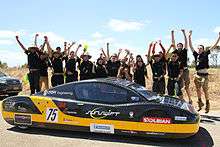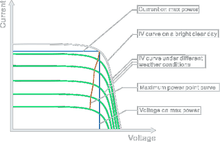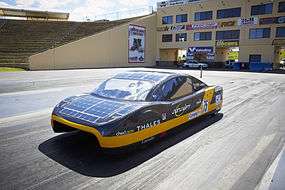UNSW Sunswift

The UNSW Solar Racing Team (also known as Sunswift after the name of their first race car) is the solar car racing team of the University of New South Wales in Sydney, Australia. The team currently holds a number of world records including the Guinness World Record for the fastest solar powered vehicle, and is best known for its participation in the World Solar Challenge (WSC). Since its founding in 1996 by Byron Kennedy, the Sunswift team has built a total of 5 different cars, the most recent of which is Sunswift V (also known as eVe).
Sunswift Team


The team primarily consists of undergraduate students from various disciplines including business, engineering and industrial design. Despite its team members being largely engaged in full-time study, Sunswift has remained competitive in all participated solar car challenges, earning prestige and recognition on the world stage as well as training young engineers to be on the cutting edge of their profession. A number of former Sunswift team members have moved on to establishing their own companies and others have attained highly sought-after positions in the workforce; for example, working as part of well-established racing teams such as those in Formula 1. Some of these team members remain in contact with Sunswift even after graduation, and act as mentors or advisors to the newer recruits, thus helping to continue the standard of excellence that has been embodied in the team since its founding in 1996.
Outreach program


The Sunswift team also plays an active role in the local community by educating the general public about the advantages of solar versus conventionally powered vehicles. To this end, they regularly showcase the series of Sunswift cars at exhibitions and hold information days open to the public. In addition, Sunswift also visits schools in order to teach and inspire young children about implementing solar power technology whilst demonstrating how it can be a fun and effective method of powering a car.
How it works

All solar cars have at least 5 main parts to their power system: the solar array, maximum power point tracker (MPPT), battery, motor controller and electric motor. These cars rely on converting the electromagnetic energy of the sun into electrical energy, through the use of photovoltaic cells, and then converting that electrical energy into mechanical energy to drive the car, through the use of some form of electric motor. Maximum power point trackers act as an interface between the solar array and the battery, while motor controllers act as an interface between the battery and the electric motors.
As sunlight shines on the solar array, it transfers energy to the electrons within the photovoltaic cells, thus allowing them to conduct electricity and causing a current to flow. This current then travels to the MPPTs which alter the load across the solar array in order to ensure that it is generating electricity as efficiently as possible. The MPPTs have to constantly monitor the output of the photovoltaic cells because that output depends on the light intensity which can change rapidly if some cells become shaded. The electricity then flows into the battery where it can be stored for later use such as to drive the car while there is no sunlight. Although the battery is primarily charged by the solar panels, it can also be externally charged by the conventionally generated electricity at your home or workplace. The battery then discharges the current into the motor controllers which converts it into a form that can be used to power the electric motor. Motor controllers are also used to manage things like speed regulation, cruise control and regenerative braking. Regenerative braking is using the existing motors as generators by converting the rotational energy of the wheels back into electrical energy, slowing the car down and recharging the battery at the same time, instead of just using conventional mechanical breaks. Lastly, the energy that was once in the sunlight shining on the car, reaches the electric motors which operate on the principles of electromagnetism to turn that electrical energy into rotational energy that spins the wheels and drives the car forward.
Sunswift V (eVe) (2012 - current)


The design and construction of eVe began in early 2012 and was completed within 18 months in time for the 2013 World Solar Challenge. The car cost approximately $500,000 and was built to compete in the new Cruiser Class in the WSC. This class focused on more practical solar cars with passenger seats, greater safety and more efficient batteries. To reflect its focus on practicality, the team also designed it to resemble a modern-day sports car, rather than the typical space aged style of most other solar vehicles. The car was the fastest vehicle in the Cruise Class, achieving Line Honours and overall third place for the Cruiser class while also attaining the highest top speed of 128 kilometres per hour (80 mph).
On a single charge of its batteries, eVe can travel up to 500 kilometres (310 mi) or over 800 kilometres (500 mi) if powered by its own solar cells. Once fully depleted, the batteries can be completely recharged in 10 hours using a standard household power socket or in under 7 hours using a commercial power socket. In terms of cost and efficiency, for every 100 km the solar car would cost approximately $0.20 compared to the average $15 for conventional petrol powered cars.
In July 2014 The Sunswift team broke an FIA World Record which was overseen by the Confederation of Australian Motorsport, for the fastest electric vehicle capable of travelling 500 kilometres (310 mi) on a single battery charge.[1] The team beat the previous record 73 kilometres per hour (45 mph) - set in 1988 - with an average speed of 107 kilometres per hour (66 mph) over the 500 kilometres (310 mi) distance, which was done at the Australian Automotive Research Centre in Victoria. This record was not an exclusive Solar car record, but was open to any Electric vehicle weighing under 500 kilograms (1,100 lb). Consequently, for this record the Solar cells were disconnected from the electrical systems, and the car was allowed to only run on its lithium-ion battery pack.
In 2015 the team plans to officially register their car to be Australia's first road legal Solar car. This would make eVe one of the only road legal solar cars in the world and the first to adhere to the strict Australian Design Rules.
| Technical specifications for eVe | |
|---|---|
| Dimensions | Length: 4.5 metres (15 ft) Width: 1.8 metres (5 ft 11 in) Height: 1.1 metres (3 ft 7 in) |
| Weight | 430 kilograms (950 lb) |
| Solar Cells/Array | 4-square-metre (43 sq ft) array. All cells are monocrystalline silicon with an approximate efficiency of >23% |
| Seats | 2 made of carbon fiber, each with a 3-point safety harness |
| Chassis | Carbon fiber monocoque with foam and an aramid honeycomb core |
| Motors | Twin, rear wheel, in hub, synchronous DC motors, both of which are brushless and have permanent magnets |
| Maximum speed | Achieved: 132 kilometres per hour (82 mph) Theoretical: 140 kilometres per hour (87 mph) |
| Battery Power | 16 kilowatt-hours (58 MJ) |
| Telemetry | Custom Controlled Area Network (CAN) including GPS, barometric pressure, motor speeds, motor temperatures, tilt, and various voltages and currents |
Sunswift IV (IVy) (2009 - 2011)

_during_the_2009_Global_Green_Challenge_from_Darwin_to_Adelaide.jpg)
As with eVe, IVy was built to compete in the World Solar Challenge, specifically for the 2009 race. However, unlike eVe, IVy raced as part of the Challenger Class and Challenger Class Silicon, ending up finishing 4th overall despite being the first silicon powered car across the line. Overall, the entire project took approximately 18 months and $250,000 to complete. On January 7, 2011, at the Royal Australian Navy airbase, HMAS Albatross, IVy broke the Guinness World Record for the fastest solar powered vehicle. Australian racing driver Barton Mawer brought IVy to a top speed of 88.5 kilometres per hour (55.0 mph), beating the previous record of 22 years by over 10 kilometres per hour (6.2 mph). The rules of the record required that IVy be powered solely by the sun and with the entire battery pack removed, the car weighed only 140 kilograms (310 lb).[2]
| Technical specifications for Sunswift IV | |
|---|---|
| Dimensions | Length: 4.6 metres (15 ft) Width: 1.8 metres (5 ft 11 in) Height: 0.93 metres (3 ft 1 in) |
| Weight | 165 kilograms (364 lb) |
| Solar Cells/Array | 5.99-square-metre (64.5 sq ft) permanent array consisting of 397 A300's at 22% efficiency and 56 UNSW TopCells at 16% efficiency |
| Seats | No conventional seat. The driver's compartment is part of the chassis |
| Chassis | Carbon fiber monocoque with pre-preg carbon fiber and a nomex honeycomb, as well as a fiberglass canopy |
| Motors | Single, rear wheel, brushless, synchronous DC motor with permanent magnets |
| Maximum speed | 88.5 kilometres per hour (55.0 mph) with only solar panels 95 kilometres per hour (59 mph) with solar panels and batteries |
| Battery Power | 4.85 kilowatt-hours (17.5 MJ) at a voltage between 89.1 and 138.6 V |
| Telemetry | Custom Controlled Area Network (CAN) including GPS, tyre pressure, motor speeds, motor temperatures, brake temperature, and various voltages and currents |
Sunswift III (2005 - 2008)

Sunswift III was designed for the 2005 WSC. Mechanical problems caused a crash before the race, and the car completed the course unofficially. In 2006, the mechanics were improved. In January 2007, Jaycar Sunswift III broke the world transcontinental record, completing the drive from Perth to Sydney in 5.5 days. In September, the team successfully completed the WSC in ninth place overall, and was also awarded the CSIRO technical innovation award, out of an initial field of 41 international entrants. The same year, the Sunswift team was awarded the 2007 Engineers Australia Engineering Excellence Award for Education and Training.
| Technical specifications for Sunswift III | |
|---|---|
| Dimensions | Length: 6.0 metres (19.7 ft) Width: 2.0 metres (6 ft 7 in) Height: 0.9 metres (2 ft 11 in) |
| Weight | 220 kilograms (490 lb) |
| Solar Array | 11.5-square-metre (124 sq ft) of 20% efficient solar cells Power output of 1.8 kilowatts (2.4 hp) |
| Chassis | Carbon fibre monoconque |
Sunswift II (1998 - 2005)

Between 1997 and 2003, the team developed, refined and raced four versions of UNSW Sunswift II. In 2000-2001, the team embarked on the TopCell project to manufacture buried contact solar cells to construct a new solar array. This makes the UNSW SRT the first and only team to have made their own solar cells. Along the way, the team achieved a new world record efficiency for this type of solar cell. The remaining cells on UNSW Sunswift II are the world's highest efficiency "PERL" silicon solar cells, made at UNSW. The team also pioneered a cell encapsulation technique which allowed the moulding of solar panels to the curved shape of the car.
| Technical specifications for Sunswift II | |
|---|---|
| Dimensions | Length: 4.4 metres (14 ft) Width: 2.0 metres (6 ft 7 in) Height: 0.9 metres (2 ft 11 in) |
| Weight | 180 kilograms (400 lb) |
| Solar Array | BP "Saturn" cells, laminated using epoxy resins and fibreglass Power output ~1 kilowatt (1.3 hp) |
| Chassis | Chromoly space frame with structural carbon fibre seat |
| Motor | UNSW/CSIRO developed electric wheel motor Maximum output 3 kilowatts (4.0 hp) |
| Suspension | Aluminium double wishbone front trailing arm and rear Ohlins Motorcycle shock absorbers |
| Battery | 102 Sony Lithium Ion Batteries Total weight 30 kilograms (66 lb) |
| Battery Power | 3 kilowatt-hours (11 MJ) at 20 V |
| Telemetry | Fluke Hydra data logger/radio modem |
Sunswift I (1996)

The original Sunswift vehicle was purchased from the Aurora Vehicle Association in 1996. The car, Aurora Q1, was significantly upgraded and improved by the UNSW SRT and renamed Sunswift, under team leader Byron Kennedy. A new motor and controller, roll cage, chassis and batteries were added. Sunswift I then went on to race in the 1996 World Solar Challenge. The car was still a competitive entry despite its age, placing 9th out of over 46 entries. The experience gained from racing Sunswift I inspired the development of Sunswift II starting in 1997.
| Technical specifications for Sunswift I | |
|---|---|
| Total cost | $95,000 + $200,000 for purchase of the Aurora Q1 |
| Dimensions | Length: 4.46 metres (14.6 ft) Width: 2.0 metres (6 ft 7 in) Height: 1.01 metres (3 ft 4 in) |
| Weight | 255 kilograms (562 lb) |
| Solar Cells/Array | 7.88-square-metre (84.8 sq ft) permanent array (1923 cells). All cells were PERL mono (FZ) silicon with an average efficiency of 18.5% |
| Chassis | Aluminium rigid A-frame/glass fibre reinforced Nomex honeycomb (upper). Carbon fibre reinforced Nomex honeycomb (lower). |
| Motor | T-Flux TF406 permanent magnet DC, Brushless |
| Maximum speed | Experimental: 63 kilometres per hour (39 mph) Theoretical: 70 kilometres per hour (43 mph) |
| Battery | 58 Gates Cyclone-G12C Pb/acid cells in series |
| Battery Power | 3 kilowatt-hours (11 MJ) at 116 V |
Achievements
| Year | Record |
|---|---|
| 1996 | World Solar Challenge – Sunswift finished 9th out of 46 entries. This was the University’s first entry in a solar car event amongst the prestigious and competitive entries from Honda Motors Corporation, the Swiss entry from Biel, and Mitsubishi Materials Corporation. |
| 1999 | NRMA Transcontinental Record Attempt – with the car NRMA Sunswift II completed 4,012 kilometres (2,493 mi) in ten days, despite five days of bad weather. Even though the record of 8½ days was not broken, the attempt was still regarded to be a success with $2.4 million worth of publicity generated. |
| 1999 | CitiPower SunRace – three days after completing the Perth-Sydney record attempt the team entered this event. NRMA Sunswift II obtained third place in a highly competitive field of five entries, proving the car's reliability and the team’s dedication after five continuous weeks on the road. |
| 1999 | NRMA Sunswift II participated in a trade exhibition in Taipei, on request from the Federal Government. |
| 1999 | World Solar Challenge – NRMA Sunswift II finished a respectable 18th out of 48 international entries. |
| 2001 | World Solar Challenge - UNSW Sunswift II was the 11th car to cross the line. |
| 2002 | SunRace - 2nd Place |
| 2003 | SunRace - 2nd Place |
| 2005 | World Solar Challenge - UNSW Sunswift III was the 9th car (and the first with silicon solar cells) to cross the line, arriving in 5 days. |
| 2007 | Jaycar Sunswift III broke the world record for a solar car journey from Perth to Sydney. The team finished the journey in 5.5 days, breaking the previous record by 3 days. |
| 2007 | World Solar Challenge - Jaycar Sunswift III finished 4th in the Adventure class and 9th overall at 4:11pm on 26 October. The team was awarded with the prestigious Freescale Technical Innovation Award for the high efficiency of the vehicle. |
| 2007 | The UNSW Solar Racing Team was awarded the Engineers Australia Engineering Excellence Award, for education and training. |
| 2009 | Global Green Challenge (World Solar Evolution) - Sunswift IV finished 1st in the Silicon Challenge Class and 4th overall at 3:08pm on 29 October. |
| 2011 | Guinness World Record: Fastest Solar Powered Vehicle: 88.8 kilometres per hour (55.2 mph) |
| 2011 | World Solar Challenge - Sunswift IVy finished 1st in the Production Challenge Class and 6th overall |
| 2013 | World Solar Challenge - Sunswift eVe Line Honours and 3rd overall in Cruiser Class, including a top speed of 128 kilometres per hour (80 mph) |
| 2014 | FIA Land Speed Record - Sunswift eVe breaks the record for the fastest electric car over 500 kilometres (310 mi), with an average speed of 107 kilometres per hour (66 mph).[3] The previous record of 73 kilometres per hour (45 mph) was set in 1988 |
See also
References
- ↑ http://www.newsroom.unsw.edu.au/news/science-tech/it%E2%80%99s-official-electric-car-world-record-smashed-unsw-sunswift
- ↑ "Aussie car breaks a world speed record". AAP. 7 January 2011. Retrieved 2011-01-07.
- ↑ https://www.cams.com.au/media/news/latest-news/australian-motor-sport-team-creates-electric-world-first
External links
- UNSW Sunswift website
- UNSW Sunswift Youtube channel - includes videos of vehicle construction and achievements
